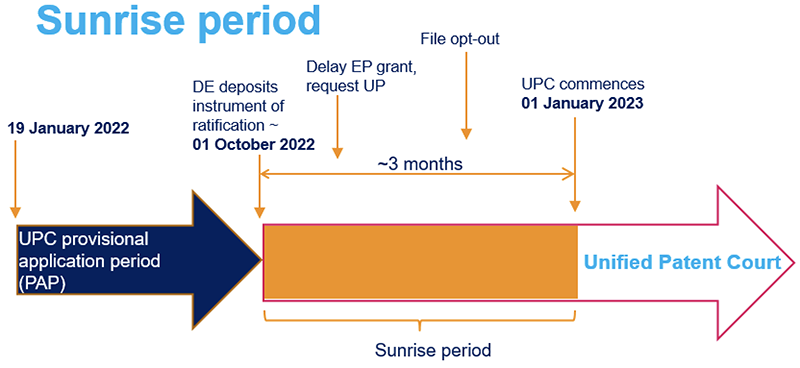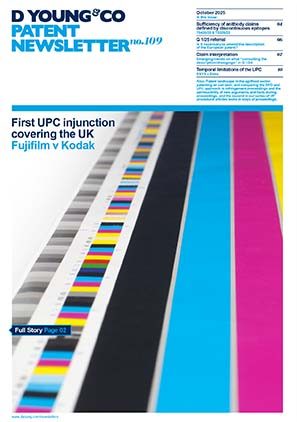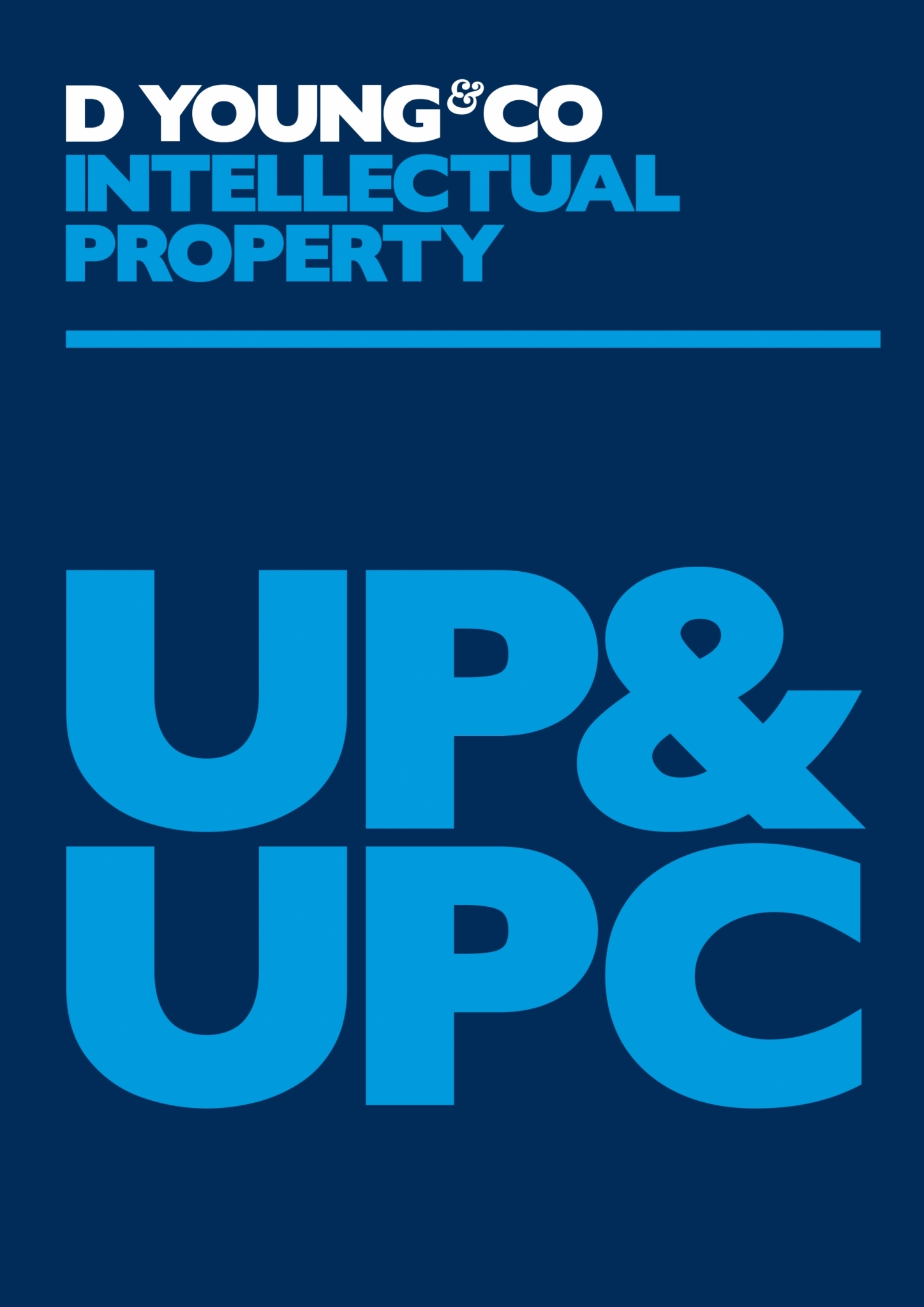Preparing for the UPC
After several false-starts, the biggest change in the European patent landscape, namely the introduction of a Unitary Patent (UP) and launch of the Unified Patent Court (UPC), is looking like a real possibility for 2022. In this article, Rachel Bateman, partner and patent attorney at D Young & Co, discusses several of the key aspects of the new system and provides some suggestions of the actions that patent owners should be taking over the next few months.
Latest UP & UPC news and developments
This article was published in March 2022. For our latest unitary patent and Unified Patent Court updates, webinars and guides, please visit the UP & UPC information hub on this webite.
Read moreTimeline
Following Austria’s deposit of its instrument of ratification for the Protocol to the Agreement of a Unified Patent Court on 18 January 2022, the UPC Preparatory Committee announced the commencement of the UPC Provisional Application Period (PAP) (see: LNB News 19/01/2022 77). The PAP allows for completion of preparatory work establishing the UPC, including stress testing of the electronic case management system and the appointment of judges.
The PAP is expected to last eight months, although this may be extended if more time is needed to complete the preparatory work.
With the PAP in effect, Germany can deposit its ratification of the UPC Agreement. Germany is the ‘gatekeeper’ because once German ratification is deposited, the new court will commence on the first day of the fourth month after the month in which that deposit occurs.
It is understood that Germany will not trigger this timetable until all preparatory work is complete. Nevertheless, the UPC and UP system could come into force between in early 2023.
Sunrise period
Ratification by Germany will determine the beginning of the ‘sunrise period’—a three-month window before the UPC becomes fully operational. The sunrise period is important—it is when patent owners are able to file ‘opt-outs’ for existing European patents and associated SPCs, and for pending European applications.
Opting out in the sunrise period means that patent owners can avoid the jurisdiction of the UPC before it comes into effect.
A possible timing of the sunrise period is shown in the figure below.

Opt-outs
The opt-out is a means by which a patent owner can remove their European patents and any associated SPCs, as well as their pending European patent applications from the jurisdiction of the UPC.
The default position is that all European patent applications with a filing date of 1 March 2007 or later, all European patents with a filing date of 1 March 2007 or later and validated in one or more countries participating in the UPC, and any associated SPCs, will be subject to the jurisdiction of the UPC when it comes into effect, unless an opt-out is filed.
When can an opt-out be filed?
The opt-out will be available from the beginning of the sunrise period to the end of the ‘transitional period’, provided that no action has been started in the UPC (either past or pending) when the opt-out is filed.
If Germany ratifies on 01 October 2022, the UPC will begin on 01 January 2022, and the sunrise period and opt-outs will have a start date of 01 October 2022.
The transitional period will expire at least seven years after the UPC comes into effect. It may, however, be extended by a further seven years. Continuing the above example, the transitional period could therefore expire on 01 January 2030 or 01 January 2037. An opt-out timeline with example dates is shown below.

How long will the opt-out be effective?
It is understood that the opt-out, once registered by the UPC Registry, will be effective for the lifetime of the European patent/patent application. An exception to this will be if the patent owner subsequently withdraws the opt-out. This option is, however, only available once. Withdrawal of the opt-out is permanent, it is not possible to file a second opt-out. A withdrawal is also not available if an action has been launched in the national courts.
What if no opt-out is filed?
If no opt-out is filed, the UPC will share jurisdiction over the European patent and any associated SPC(s) with the national courts. In practice this means that enforcement or third party actions can take place in the UPC or one or more national courts.
Who can file the opt-out?
Only the proprietor(s) or applicant(s) is entitled to opt-out and the European representative submitting the opt-out application will be required to complete a declaration stating that they are entitled to act on behalf of the proprietor(s)/applicant(s). The current proprietor(s)/applicant(s) might not be the owner(s) registered before the EPO or national patent office(s) meaning that the preparation of a valid declaration is likely to be key for acceptance and validity of any opt-out application.
A supplementary protection certificate (SPC) must ‘follow’ the EP patent on which it is based. This means that if the European patent is opted out, the SPC must also be opted out. If the SPC and patent are owned by different entities, then all owners must opt out in agreement.
UPC
Once the UPC becomes operational, the following points should be noted:
- UPs will become available by requesting unitary effect within one month of grant of a European patent application.
- a UP must be litigated in the UPC.
- all European patents must be litigated in the UPC for participating member states of the UPC, unless the patent owner opts out of the UPC.
- if proceedings are commenced in the UPC before an opt-out is filed, the patent owner is restricted to the jurisdiction of the UPC.
- the UK’s withdrawal from the UPC means that a European patent designating the UK can only be enforced in the UK courts. A similar situation will arise for other member states of the European Patent Court which are not members of the UP/UPC, for example Spain, Poland, Switzerland and Norway.
- the UP and UPC do not impact the European Patent Office opposition and appeal procedure.
What can be done now to prepare for the UPC?
In view of a possible start date in 2022 or early 2023, there are a few key actions that patent owners can carry out over the next few months. These include:
- Conducting a European patent and SPC audit to have full visibility of your portfolio, including ‘who owns what’. This is critical for validly filing any opt-outs. An assumption is made that the patent owner indicated on the European or National Patent Registers (the former for applications, the latter for patents) is the “true” proprietor. It may therefore be prudent to update the European/National Patent Registers in advance of the sunrise period.
- Considering opt-out options and strategy to enable decisions to be made for the sunrise period and the transitional period. Strategy may include filing one or more divisional applications, if there is a European patent application pending, so that a single patent family can include “opted-out” and “opted-in” European patent rights. A divisional patent is treated as an independent right and does not need to ‘follow’ the parent patent. The decision of whether to opt-out is likely to be case dependent.
- Discussing and agreeing patenting and opt-out strategy with all co-owners of any patent and SPC holder(s). Explicit consent from all co-owners and SPC holder(s) is required for a validly filed opt-out. It is not possible to divide a European patent between co-owners or for any SPC to be subject to the jurisdiction of the UPC when the patent on which it is based is opted-out, and vice versa.
- Monitoring competitors’ or third party patents to understand patenting vs opt-out strategy. It may be possible to deduce from competitor activity which patents are considered ‘business-critical’ and therefore opted-out of the UPC. The filing of any divisional applications(s) may also be informative.
- Reviewing patent and SPC licences and agreements for UPC/UP clauses. Such clauses could, for example, address whether the patent and SPC will be opted-out, whether unitary effect will be requested once a European patent application grants, whether the licensee is able to bring an action in the UPC or a National Court, and the arrangements if a third party approaches a licensee for acknowledgement of a non-infringing act.
Exclusive licensees are permitted to bring an action in the UPC provided the proprietor is notified and unless the licence provides otherwise. This may be problematic because if a licensee starts an action, an opt-out can no longer be filed and the patent will be open to central revocation by the UPC. It may therefore be advisable for an exclusive license to provide for consent to be obtained before an action is launched in the UPC. For opted-out patents, the license should also address the issue of consent before launch of an action in a National Court to ensure that the licensor/proprietor retains control of whether it is still possible to withdraw the opt-out.
Non-exclusive licensees do not have the right to commence proceedings for infringement without the consent of the licensor/proprietor. Express provision should therefore be made in this respect. Again, the effect on any opt-out or withdrawal of an opt-out should be considered at the time of any request for consent to commence proceedings.


